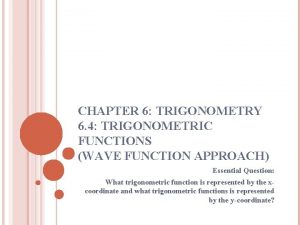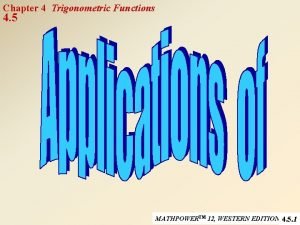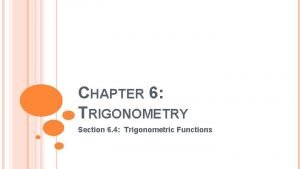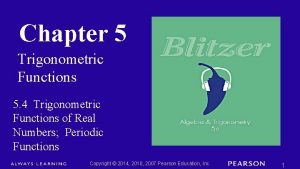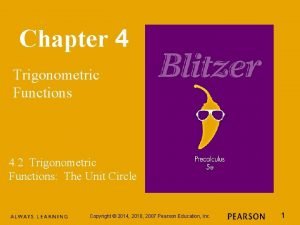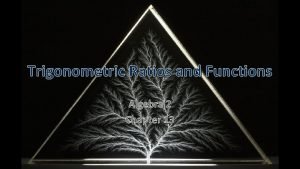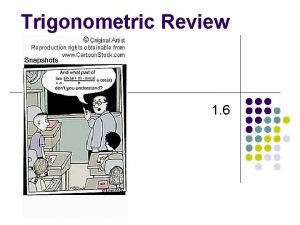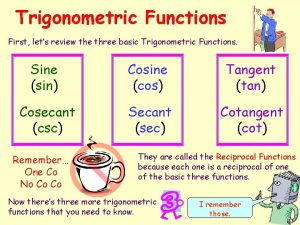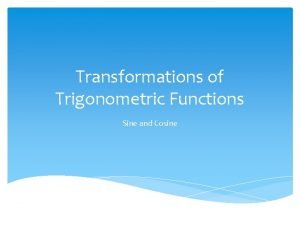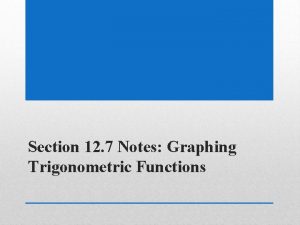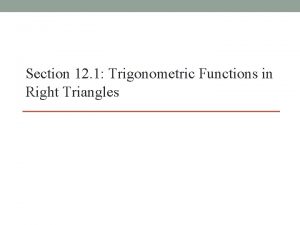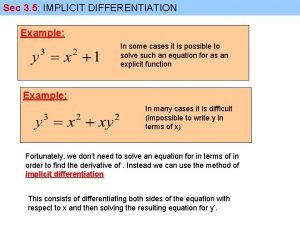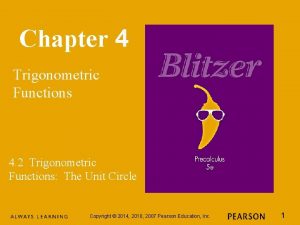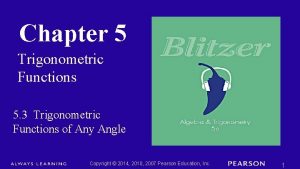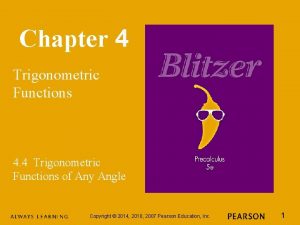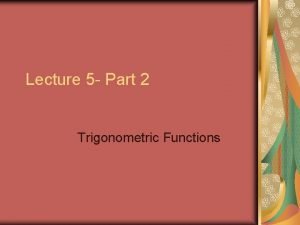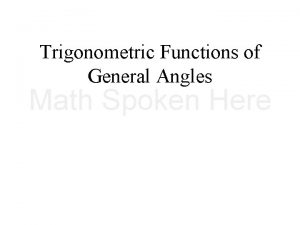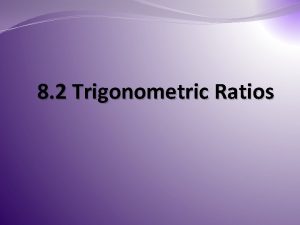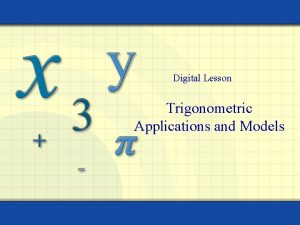Chapter 5 Trigonometric Functions 5 8 Applications of












- Slides: 12

Chapter 5 Trigonometric Functions 5. 8 Applications of Trigonometric Functions Copyright © 2014, 2010, 2007 Pearson Education, Inc. 1

Objectives: Solve a right triangle. Solve problems involving bearings. Copyright © 2014, 2010, 2007 Pearson Education, Inc. 2

Solving Right Triangles Solving a right triangle means finding the missing lengths of its sides and the measurements of its angles. We will label right triangles so that side a is opposite angle A, side b is opposite angle B, and side c, the hypotenuse, is opposite right angle C. When solving a right triangle, we will use the sine, cosine, and tangent functions, rather than their reciprocals. Copyright © 2014, 2010, 2007 Pearson Education, Inc. 3

Example: Solving a Right Triangle Let A = 62. 7° and a = 8. 4. Solve the right triangle, rounding lengths to two decimal places. Copyright © 2014, 2010, 2007 Pearson Education, Inc. 4

Example: Finding a Side of a Right Triangle From a point on level ground 80 feet from the base of the Eiffel Tower, the angle of elevation is 85. 4°. Approximate the height of the Eiffel Tower to the nearest foot. The height of the Eiffel Tower is approximately 994 feet. Copyright © 2014, 2010, 2007 Pearson Education, Inc. 5

Example: Finding an Angle of a Right Triangle A guy wire is 13. 8 yards long and is attached from the ground to a pole 6. 7 yards above the ground. Find the angle, to the nearest tenth of a degree, that the wire makes with the ground. The wire makes an angle of approximately 29. 0° with the ground. Copyright © 2014, 2010, 2007 Pearson Education, Inc. 6

Trigonometry and Bearings In navigation and surveying problems, the term bearing is used to specify the location of one point relative to another. The bearing from point O to point P is the acute angle, measured in degrees, between ray OP and a north-south line. The north-south line and the east-west line intersect at right angles. Each bearing has three parts: a letter (N or S), the measure of an acute angle, and a letter (E or W). Copyright © 2014, 2010, 2007 Pearson Education, Inc. 7

Trigonometry and Bearings (continued) If the acute angle is measured from the north side of the north-south line, then we write N first. Second, we write the measure of the acute angle. If the acute angle is measured on the east side of the north-south line, then we write E last. Copyright © 2014, 2010, 2007 Pearson Education, Inc. 8

Trigonometry and Bearings (continued) If the acute angle is measured from the north side of the north-south line, then we write N first. Second, we write the measure of the acute angle. If the acute angle is measured on the west side of the north-south line, then we write W last. Copyright © 2014, 2010, 2007 Pearson Education, Inc. 9

Trigonometry and Bearings (continued) If the acute angle is measured from the south side of the north-south line, then we write S first. Second, we write the measure of the acute angle. If the acute angle is measured on the east side of the north-south line, then we write E last. Copyright © 2014, 2010, 2007 Pearson Education, Inc. 10

Example: Understanding Bearings Use the figure to find each of the following: a. the bearing from O to D Point D is located to the south and to the east of the north-south line. The bearing from O to D is S 25°E. b. the bearing from O to C Point C is located to the south and to the west of the north-south line. The bearing from O to C is S 15°W. Copyright © 2014, 2010, 2007 Pearson Education, Inc. 11

Copyright © 2014, 2010, 2007 Pearson Education, Inc. 12
 Evaluating the six trigonometric functionsassignment
Evaluating the six trigonometric functionsassignment Chapter 4 trigonometric functions
Chapter 4 trigonometric functions Six trigonometric functions of special angles
Six trigonometric functions of special angles Chapter 5 trigonometric functions
Chapter 5 trigonometric functions Chapter 4 trigonometric functions
Chapter 4 trigonometric functions Algebra 2 quiz 13
Algebra 2 quiz 13 Cofunction identity
Cofunction identity Three basic trigonometric functions
Three basic trigonometric functions Transformation of trigonometric functions
Transformation of trigonometric functions How to find the period of a cosine function
How to find the period of a cosine function 12-7 graphing trigonometric functions answers
12-7 graphing trigonometric functions answers 12-1 trigonometric functions in right triangles
12-1 trigonometric functions in right triangles Derivative implicit
Derivative implicit
